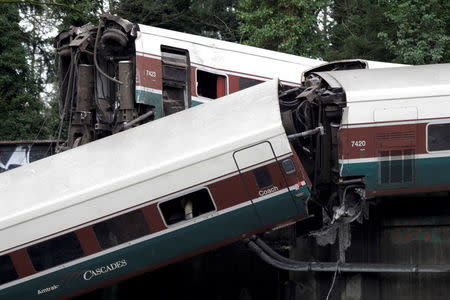U.S. investigators seek to interview train crew in Washington derailment
By Tom James
DUPONT, Wash. (Reuters) - Safety investigators hope the engineer of an Amtrak passenger train that careened off a bridge onto a highway in Washington state can help explain why his locomotive was going more than twice the speed limit when the deadly derailment occurred, officials said on Tuesday.
National Transportation Safety Board (NTSB) officials said they plan to interview all the crew members in the next two days, once they sufficiently recover from injuries suffered in the wreck, including a conductor-in-training who was in the locomotive cab with the engineer at the time.
Safety board member T. Bella Dinh-Zarr told reporters that NTSB investigators would seek to determine, among other factors routinely examined, whether the engineer was distracted while driving the ill-fated train.
She also said investigators had determined that the train's emergency brakes were automatically activated while the derailment was occurring, rather than engaged manually by the engineer.
In addition, she confirmed that a safety system known as positive train control (PTC), which automatically slows trains if they are going too fast, was not installed on the section of track where the wreck occurred.
None of the crew, all of whom are believed to have survived, has been identified, and were hospitalized, Dinh-Zarr said.
Three people aboard the train were killed in the Monday morning wreck near the town of DuPont, in which all 12 carriages and one of the train's two locomotives tumbled off the rails, officials said. Another 100 people were taken to hospitals, 10 with serious injuries.
Some motorists on Interstate 5 were among the injured, though nobody on the highway died.
The accident occurred as the train was making its inaugural run on a new, slightly quicker route between Seattle and Portland, Oregon, with 86 people aboard, 80 of them passengers, Amtrak said.
Recorded data recovered from the rear locomotive showed the train was going 80 miles (129 km) per hour on a curved stretch of track where the speed limit was 30 mph (48 kph), National Transportation Safety Board (NTSB) officials said on Monday night. The board said it was investigating whether other factors besides speed were involved.
Speaking at an afternoon news conference on Tuesday, Dinh-Zarr said that a conductor "who was getting experience and familiarizing himself with the territory" was present in the locomotive cab with the engineer. NTSB spokesman Peter Knudson described that second Amtrak employee as a "conductor-in-training."
Dinh-Zarr said it was not unusual for conductors who are learning a new train route to ride in the cab with the engineer. She said another conductor was posted in the passenger section of the train at the time.
The derailment placed Amtrak, the country's main passenger rail service, under renewed scrutiny following a series of fatal incidents.
(Additional reporting by Jonathan Allen in New York and Alex Dobuzinskis in Los Angeles. Writing by Jonathan Allen and Steve Gorman; Editing by Jonathan Oatis and Cynthia Osterman)



